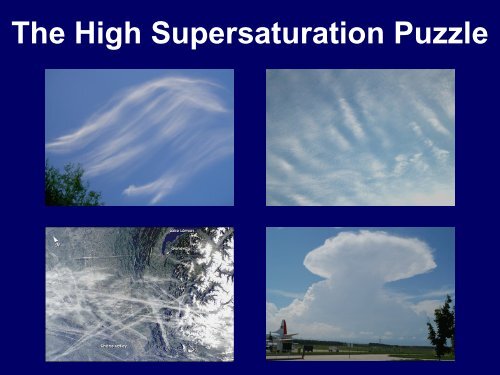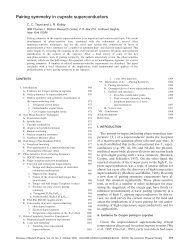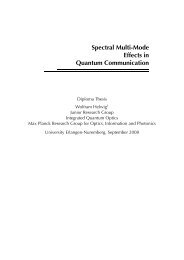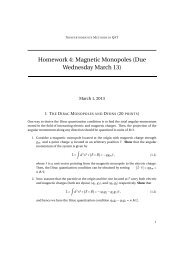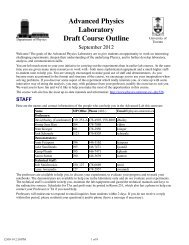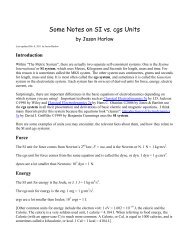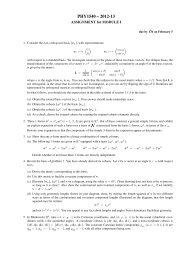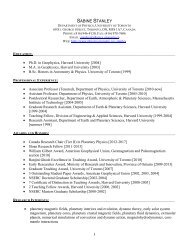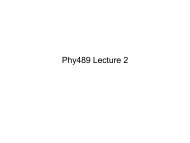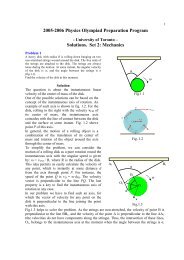PDF file - Department of Physics
PDF file - Department of Physics
PDF file - Department of Physics
You also want an ePaper? Increase the reach of your titles
YUMPU automatically turns print PDFs into web optimized ePapers that Google loves.
The High Supersaturation Puzzle
The High Supersaturation Puzzle<br />
Thomas Peter, Claudia Marcolli, Peter Spichtinger,<br />
Thierry Corti<br />
Institute for Atmospheric and Climate Science, ETH Zurich, Switzerland<br />
Marcia Baker<br />
Atmospheric Sciences, University <strong>of</strong> Washington, Seattle, Wash., USA<br />
Thomas Koop<br />
<strong>Department</strong> <strong>of</strong> Chemistry, Bielefeld University, Bielefeld, Germany<br />
Thanks to Martina Krämer, Jülich, and Holger Vömel, NOAA<br />
The discovery <strong>of</strong> massive supersaturations with<br />
respect to ice in upper tropospheric cloud-free air<br />
and inside ice clouds calls into question our<br />
understanding <strong>of</strong> the physics <strong>of</strong> cloud formation.
Saturation ratio with respect to ice:<br />
partial pressure <strong>of</strong> water<br />
vapor pressure <strong>of</strong> ice<br />
S > 1<br />
S = 1<br />
S < 1<br />
ice particles grow<br />
ice particles are in equilibrium with the gas phase<br />
ice particles evaporate<br />
s = S – 1 supersaturation<br />
Relative humidity wrt ice: RHI = S<br />
S = 1 RHI = 100 %
Saturation ratio with respect to ice:<br />
partial pressure <strong>of</strong> water<br />
vapor pressure <strong>of</strong> ice<br />
Arrhenius-type expression for vapor pressure:<br />
p vap (T ) = A e –B/T
Two questions central to our understanding <strong>of</strong> ice<br />
cloud formation:<br />
Nucleation and uptake kinetics:<br />
(1) At what S do we expect ice to nucleate?<br />
(2) Thereafter, how rapidly do we expect ice<br />
to grow and S to equilibrate (S 1)?
ice saturation<br />
ratio S<br />
altitude [km]<br />
14<br />
13<br />
12<br />
14<br />
13<br />
12<br />
14<br />
13<br />
12<br />
2.2<br />
1.6<br />
1<br />
nucleation<br />
threshold<br />
0 time minutes to hours
How do we expect S in a cirrus to develop dynamically?
ice saturation ratio S<br />
The supersaturation puzzle – the observations<br />
2.25<br />
2.00<br />
1.75<br />
(a) Theory (b) Aerosol Chamber (c) Clear Sky (d) In-Cloud/Contrail<br />
Experiment Observations Observations<br />
spontaneous ice nucleation<br />
and vigorous growth<br />
1.50<br />
1.25<br />
clear sky or rapid growth <strong>of</strong><br />
preexisting ice<br />
organic<br />
carbon<br />
on soot<br />
contrails<br />
cirrus<br />
1.00<br />
expected cloud occurrence<br />
0.75 clear sky or ice evaporation<br />
(NH 4 ) 2 SO 4<br />
190 210 230<br />
temperature [K]<br />
190 210 230<br />
temperature [K]<br />
190 210 230<br />
temperature [K]<br />
190 210 230<br />
temperature [K]<br />
Koop et al.,<br />
Nature, 2000<br />
Möhler et al.,<br />
Meteorol. Zs.,<br />
2005,<br />
Abbatt et al.,<br />
Science, 2006<br />
Jensen et al.,<br />
Atmos. Chem.<br />
Phys., 2005<br />
Gao et al.,<br />
Science, 2004
Jensen et al., Atmos. Chem. Phys., 2005<br />
Pre-AVE campaign:<br />
Measurements made<br />
during the descent <strong>of</strong><br />
WB-57:<br />
log-normal aerosol size<br />
distribution with<br />
n = 100 cm −3 ,<br />
r m = 0.025 μ m ,<br />
= 1.4.
5-K averages, all flights<br />
Gao et al., Science, 2004
Lee et al., JGR, 2004:<br />
Measured temperature (blue), RHI (green), IWC (orange), and N4–9<br />
(black) on 23 July 2002 during CRYSTAL-FACE. Temperature and RHI are<br />
1-s averages, IWC is a 10-s average, and N4–9 is a 30-s average.
A meteorological curiosity?<br />
Why should we be interested?
Increasing stratospheric humidity<br />
Important effects:<br />
Stratosphere cools<br />
Stratospheric HO x<br />
chemistry enhanced<br />
H 2<br />
O-trend, frost-point hygrometers above<br />
Colorado 1979-99 (courtesy Sam Oltmans)
Supersatuation:<br />
Decreasing tropical cloudiness?
“T hey live for a short tim e in very high clouds. In a pocket <strong>of</strong> m otionlessness<br />
their temperature will drop to – 40ºC . T hey ought to freeze, but they don’t.”<br />
Peter Høeg, M iss S m illa’s feeling for snow
Water-activity-based ice nucleation theory<br />
H 2<br />
SO 4<br />
HNO 3<br />
HNO 3<br />
/H 2<br />
SO 4<br />
NH 4<br />
HSO 4<br />
(NH 4<br />
) 2<br />
SO 4<br />
NH 4<br />
F<br />
LiCl NaCl KCl<br />
NH 4<br />
Cl CaCl 2<br />
MnCl 2<br />
Ca(NO 3<br />
) 2<br />
H 2<br />
O 2<br />
urea<br />
ethylene glycol glucose
Atmospheric Application<br />
Water Activity<br />
Concentration <strong>of</strong> Aerosol Solution
Dependence <strong>of</strong> nucleation rate on S<br />
An increase<br />
S = 0.05<br />
results in<br />
nuc 10 -6 nuc
ice saturation ratio S<br />
What does this mean for the observations?<br />
2.25<br />
2.00<br />
1.75<br />
(a) Theory (b) Aerosol Chamber (c) Clear Sky (d) In-Cloud/Contrail<br />
Experiment Observations Observations<br />
spontaneous ice nucleation<br />
and vigorous growth<br />
1.50<br />
1.25<br />
clear sky or rapid growth <strong>of</strong><br />
preexisting ice<br />
organic<br />
carbon<br />
on soot<br />
contrails<br />
cirrus<br />
1.00<br />
expected cloud occurrence<br />
0.75 clear sky or ice evaporation<br />
(NH 4 ) 2 SO 4<br />
190 210 230<br />
temperature [K]<br />
190 210 230<br />
temperature [K]<br />
190 210 230<br />
temperature [K]<br />
190 210 230<br />
temperature [K]<br />
nuc 1 min<br />
nuc
How does water vapor condense on ice particles?<br />
5 s<br />
D * <br />
modified diffusion<br />
constant including<br />
limitation by mass<br />
accomodation ()<br />
10<br />
20<br />
CRYSTAL-FACE<br />
600 300 120 s<br />
60 .
How does water vapor condense on ice particles?<br />
Sedimentation<br />
How could supersaturation be maintained?
…<br />
…<br />
Sedimentation<br />
How does water vapor condense on iceparticles?
Steady-state S to a good approximation
Steady-state S in cirrus: traditional microphysical understanding<br />
S = 1.3<br />
w = 0.1 m/s<br />
Low number-density cirrus:<br />
Equilibrium curves for<br />
steady-state S = 1.3.<br />
S = 1.3<br />
w = 1.0 m/s<br />
p = 100 hPa<br />
T = 200 K<br />
= 1<br />
S 0 = 1.6
Steady-state S in cirrus: traditional microphysical understanding<br />
S = 1.3<br />
w = 0.1 m/s<br />
Low number-density cirrus:<br />
Equilibrium curves for<br />
steady-state S = 1.3.<br />
S = 1.3<br />
w = 1.0 m/s<br />
p = 100 hPa<br />
T = 200 K<br />
= 1<br />
S 0 = 1.6<br />
Including<br />
sedimentation<br />
in a layer <strong>of</strong><br />
thickness:<br />
z = 100 m<br />
z = 1000 m
Steady-state S in cirrus: traditional microphysical understanding<br />
w = 1.0 m/s<br />
= 0.1 … 1<br />
CRYSTAL-FACE<br />
S = 1.3<br />
CRYSTAL-<br />
FACE data<br />
could be<br />
explained<br />
assuming<br />
strong<br />
updrafts and<br />
low mass<br />
accommodation<br />
w = 0.1 m/s<br />
= 0.1 … 1<br />
w = 10 m/s<br />
= 0.1 … 1
Steady-state S in cirrus: traditional microphysical understanding<br />
w = 1.0 m/s<br />
= 0.1 … 1<br />
CRYSTAL-FACE<br />
S = 1.1<br />
CRYSTAL-<br />
FACE data<br />
could be<br />
explained<br />
assuming<br />
strong<br />
updrafts and<br />
low mass<br />
accommodation<br />
w = 0.1 m/s<br />
= 0.1 … 1<br />
w = 10 m/s<br />
= 0.1 … 1
Explanations??? Hypotheses??? Speculations???<br />
How good are the data?<br />
Potential out-<strong>of</strong>-cloud effects:<br />
Lack <strong>of</strong> preexisting aerosol?<br />
Underestimated vapor pressure <strong>of</strong> supercooled water?<br />
Surface nucleation?<br />
Potential in-cloud effects:<br />
Control by ice nuclei?<br />
Mesoscale temperature fluctuations?<br />
Subresolution patchiness?<br />
HNO 3 deposition on ice, forming NAT?<br />
Intrinsic limitations on growth <strong>of</strong> ice?<br />
Cubic ice?<br />
Overpopulated tail <strong>of</strong> high velocity molecules?
Several slides with unpublished data<br />
removed here<br />
New results from Pre-AVE campaign<br />
Aircraft-balloon intercomparisons<br />
European measurements from<br />
Geophysica and the German Learjet
Conclusion: how good are the data?<br />
The balloon-borne RHI are significantly<br />
lower than the aircraft-borne RHI = S.<br />
The aircraft-borne data show significant<br />
discrepancies with respect to each other.<br />
However, all data sets show large S – 1,<br />
exceeding the homogeneous freezing limit<br />
and – at times – even exceeding pure<br />
liquid water saturation.<br />
All data show significant persistent<br />
S – 1 >> 0 inside clouds.
Shilling et al., Vapor Pressure <strong>of</strong> Cubic Ice, GRL 2006<br />
RHI<br />
cub<br />
hex<br />
Gao et al.; Harvard water vapor instrument<br />
Shilling et al.: JPL tunable diode laser hygrometer<br />
> sublimation <strong>of</strong> crystals in the inlet <strong>of</strong> the HWV can result in anomalously<br />
high H 2 O<br />
> include only measurements when cond < 3 minutes<br />
> include only measurements when w < 0.5 m/s
Explanations??? Hypotheses??? Speculations???<br />
How good are the data?<br />
Potential out-<strong>of</strong>-cloud effects:<br />
Lack <strong>of</strong> preexisting aerosol?<br />
Underestimated vapor pressure <strong>of</strong> supercooled water?<br />
Surface nucleation?<br />
Potential in-cloud effects:<br />
Control by ice nuclei?<br />
Mesoscale temperature fluctuations?<br />
Subresolution patchiness?<br />
HNO3 deposition on ice, forming NAT?<br />
Intrinsic limitations on growth <strong>of</strong> ice?<br />
Cubic ice?<br />
Overpopulated tail <strong>of</strong> high velocity molecules?
Potential out-<strong>of</strong>-cloud effects:<br />
Lack <strong>of</strong> preexisting aerosol?<br />
Jensen et al., 2005:<br />
Measurements made during the<br />
descent:<br />
log-normal aerosol size distribution<br />
n = 100 cm −3 , r m = 0.025 μ m , = 1.4<br />
Debra Weisenstein, 2-D<br />
aerosol model, from<br />
“A ssessm ent <strong>of</strong> S tratospheric<br />
A erosol P roperties”,<br />
SPARC Report
Potential out-<strong>of</strong>-cloud effects:<br />
Underestimated vapor pressure <strong>of</strong> supercooled water?<br />
Outside ice clouds the determination <strong>of</strong> the relative<br />
humidity at which ice nucleation occurs depends also on<br />
the saturation vapor pressure <strong>of</strong> supercooled water,<br />
which has to be extrapolated for use below 230 K (8),<br />
possibly leading to errors up to 20 %.<br />
However, if the error was really that large, should it not<br />
have been caught in laboratory experiments?
ice saturation ratio S<br />
Potential out-<strong>of</strong>-cloud effects:<br />
Surface nucleation?<br />
If water-rich aerosols are<br />
covered by organic<br />
surfactants, nucleation might<br />
be suppressed if it starts at the<br />
surface (A. Tabazadeh and<br />
coworkers).<br />
But evidence for surface<br />
nucleation is controversial.<br />
Furthermore, it is not known<br />
how likely complete coverage<br />
by organics on the aerosols is.<br />
2.25<br />
2.00<br />
1.75<br />
1.50<br />
1.25<br />
1.00<br />
(a) Theory<br />
spontaneous ice nucleation<br />
and vigorous growth<br />
clear sky or rapid growth <strong>of</strong><br />
preexisting ice<br />
expected cloud occurrence<br />
0.75 clear sky or ice evaporation<br />
(NH 4 ) 2 SO 4<br />
190 210 230<br />
temperature [K]<br />
(b) Aerosol Chamber<br />
Experiment<br />
organic<br />
carbon<br />
on soot<br />
190 210 230<br />
temperature [K]
Potential in-cloud effects:<br />
Control by ice nuclei?<br />
The presence <strong>of</strong> heterogeneous ice nuclei in<br />
cloud-free air may initiate ice nucleation below the<br />
homogeneous nucleation threshold, leading to<br />
clouds with low ice particle number densities, in<br />
which supersaturations might be sustained for<br />
relatively long periods.<br />
… but how can this provide a persistent effect?
Potential in-cloud effects:<br />
Mesoscale temperature fluctuations?<br />
T oscillations – due to<br />
the nonlinearity <strong>of</strong> the<br />
Clausius-Clapeyron<br />
equation – may cause<br />
average<br />
supersaturations.<br />
… but average is not<br />
persistent, and the effect<br />
is moderate.<br />
Campaigns:<br />
A SUCCESS<br />
B CRYSTAL-FACE<br />
C SESAME PSC<br />
t / 2 cond
Potential in-cloud effects:<br />
Subresolution patchyness?<br />
Cirrocumulus undulatus, 15 Sept 2006 above Zürich
Potential in-cloud effects:<br />
HNO 3 deposition on ice, forming NAT?<br />
From Gao<br />
et al.,<br />
Science<br />
2004<br />
Blocking<br />
<strong>of</strong> growth<br />
sites?<br />
But no lab<br />
evidence!.
Potential in-cloud effects:<br />
Intrinsic limitations on growth <strong>of</strong> ice?<br />
Pratte et al., The Kinetics <strong>of</strong> H 2 O<br />
Vapor Condensation and Evaporation<br />
on Different Types <strong>of</strong> Ice in the<br />
Range 130-210 K, JPC, 2006
ice saturation ratio S<br />
Potential in-cloud effects:<br />
Cubic ice?<br />
Recent laboratory<br />
studies have shown that<br />
below 200 K a<br />
metastable form <strong>of</strong> ice –<br />
cubic ice – nucleates<br />
first and might persist in<br />
clouds. The equilibrium<br />
vapor pressure for cubic<br />
ice is about 10 % higher<br />
than that over stable<br />
hexagonal ice.<br />
2.25<br />
2.00<br />
1.75<br />
1.50<br />
1.25<br />
1.00<br />
0.75<br />
(a) Theory<br />
spontaneous ice nucleation<br />
and vigorous growth<br />
clear sky or rapid growth <strong>of</strong><br />
preexisting ice<br />
expected cloud occurrence<br />
clear sky or ice evaporation<br />
190 210 230<br />
temperature [K]<br />
contrails<br />
(d) In-Cloud/Contrail<br />
Observations<br />
cirrus<br />
190 210 230<br />
temperature [K]<br />
But unlikely higher!
Potential in-cloud effects:<br />
Overpopulated tail <strong>of</strong> high velocity molecules?<br />
Molecular velocity distributions and generalized scale<br />
invariance in the turbulent atmosphere<br />
Tuck et al., Faraday Discuss., 2005<br />
An overpopulated tail <strong>of</strong> high velocity molecules in atmospheric<br />
probability distribution functions will also affect the access <strong>of</strong> condensable<br />
vapours to particle surfaces, particularly in the case <strong>of</strong> water, which as a<br />
relatively light molecule may be expected to show a relatively high<br />
overpopulation <strong>of</strong> translationally hot molecules. Calculations <strong>of</strong> vapour<br />
flux to ice crystals, for example in polar stratospheric clouds or high cirrus<br />
near the tropical tropopause, could incur substantial error by using<br />
traditional x 2 2 Dt formulations <strong>of</strong> molecular diffusion.<br />
… how ever, isn’t this contradicting laboratory evidence?
Summary <strong>of</strong> Potential Explanations:<br />
Data quality:<br />
There are significant discrepancies whose origin needs to be investigated!<br />
However, there is little doubt that the observed S cannot be explained on<br />
the basis <strong>of</strong> traditional microphysics!<br />
Potential out-<strong>of</strong>-cloud effects:<br />
Lack <strong>of</strong> preexisting aerosol?<br />
But air masses would need to be almost void <strong>of</strong> aqueous aerosols.<br />
Underestimated vapor pressure <strong>of</strong> supercooled water?<br />
But the required > 20 % error is not supported by laboratory evidence.<br />
Surface nucleation?<br />
If ice nucleated at aerosol surface and the surface was completely<br />
covered by organics …
Summary <strong>of</strong> Potential Explanations:<br />
Potential in-cloud effects:<br />
Control by ice nuclei?<br />
Ice nuclei might suppress homogeneous nucleation, but it remains<br />
unclear how this can lead to persistent S > 1.<br />
Mesoscale temperature fluctuations?<br />
Due to the nonlinearity <strong>of</strong> the Clausius-Clapeyron relation, fluctuations<br />
cause an average, but not the observed continuous supersaturation.<br />
Subresolution patchiness?<br />
Ice patchiness may cause apparent in-cloud supersaturation, but a<br />
verification will have to await higher resolution instrumentation.<br />
HNO 3 deposition on ice, forming NAT?<br />
Nitric acid trihydrate (NAT) blocking growth sites on the ice, but<br />
laboratory investigations <strong>of</strong> this effect are not clarifying the issue.<br />
Intrinsic limitations on growth <strong>of</strong> ice?<br />
Recent lab studies suggest impeded growth due to low H 2 O mass<br />
accommodation, but how can the resulting S be as persistent?<br />
Cubic ice?<br />
Lab studies show that cubic ice forms as a transient at temperatures<br />
below 190 K, but this cannot explain S > 1.1.<br />
Overpopulated tail <strong>of</strong> high velocity molecules?<br />
Translationally hot water molecules could reduce the access <strong>of</strong> condensable<br />
vapor to particle surfaces, but w/o experimental evidence.
Summary <strong>of</strong> Potential Explanations:<br />
The way forward?<br />
Suggestion:<br />
Dedicated workshop: involved instrumentalists,<br />
key lab people, key cloud/aerosol modellers and ice<br />
theoreticians!<br />
Dedicated instrument intercomparisons, e.g. in a<br />
cloud chamber!<br />
Dedicated lab investigations on impurities on ice!


